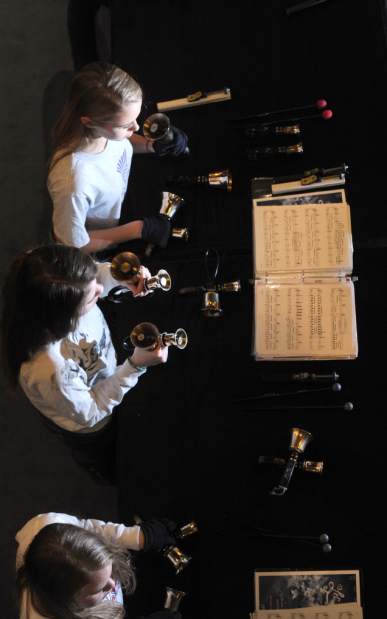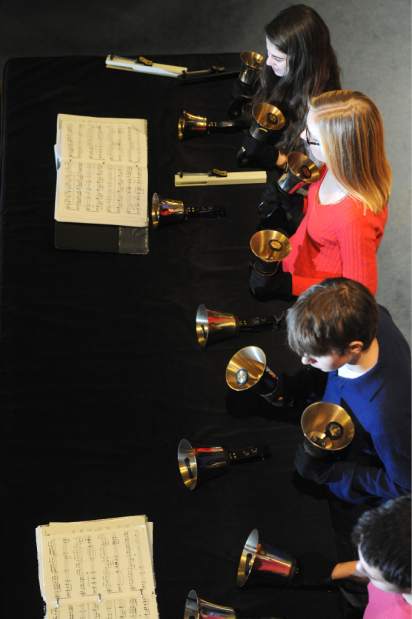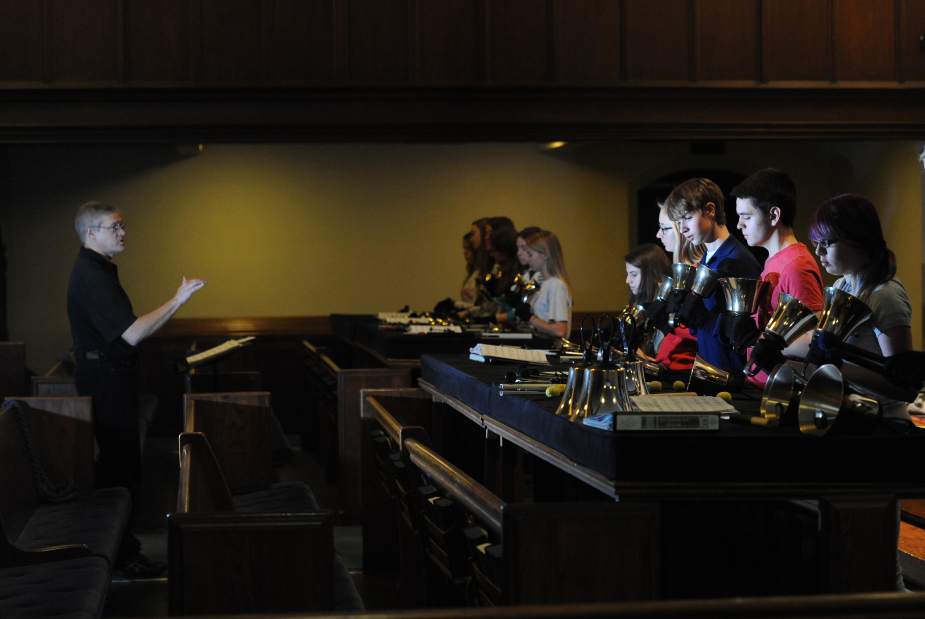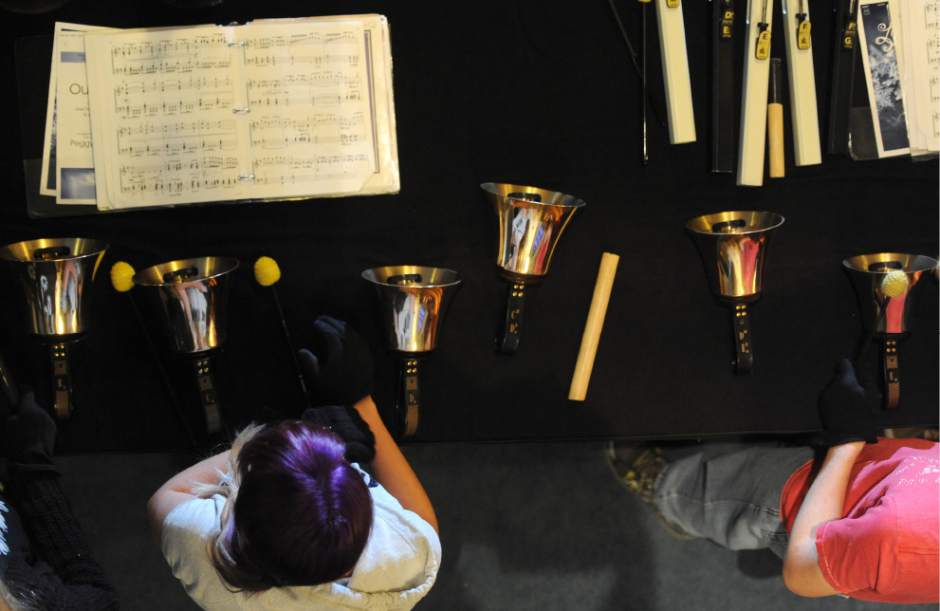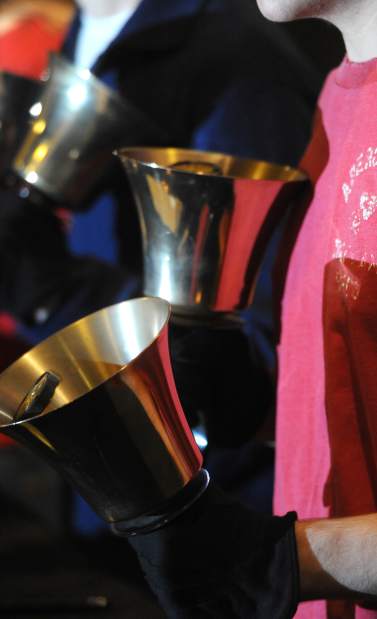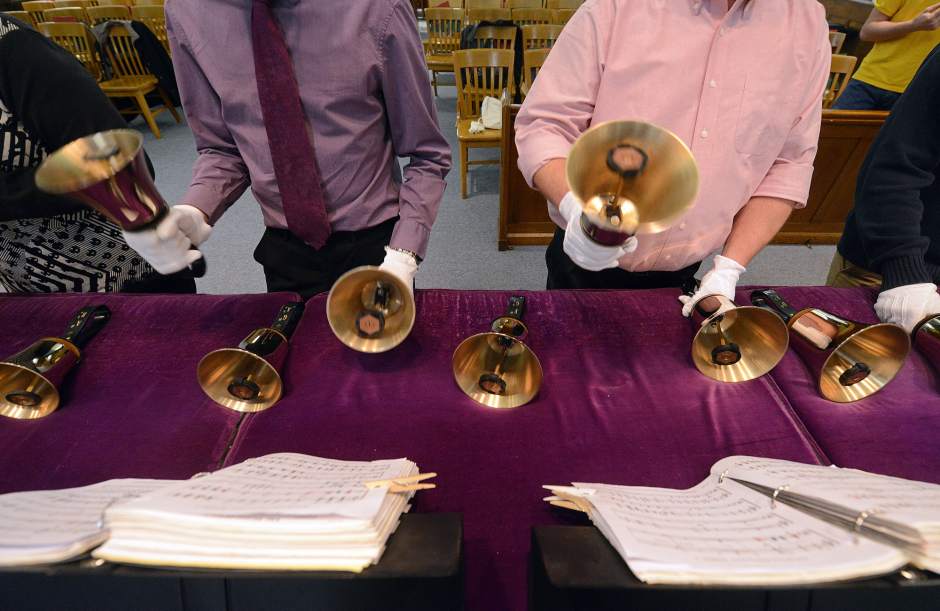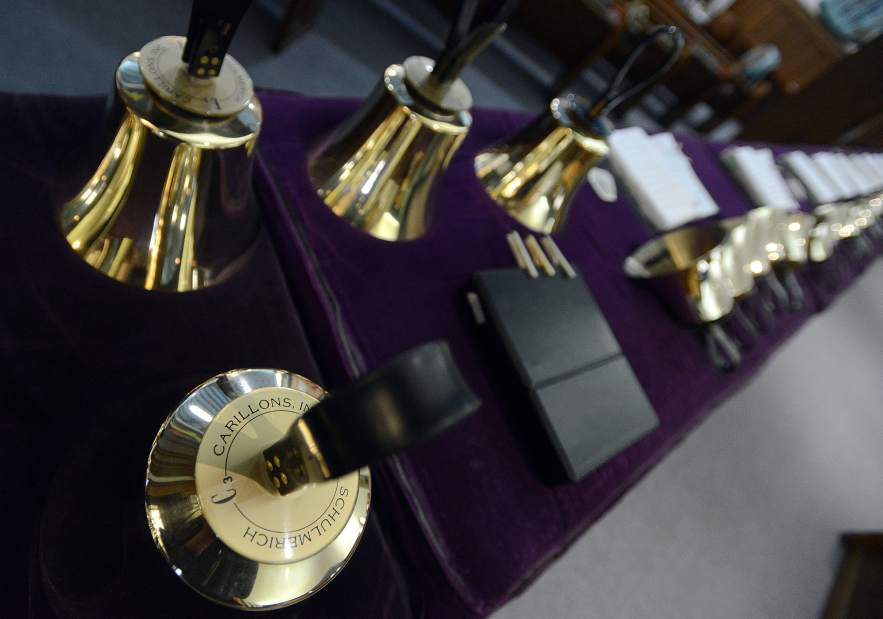Bell choirs work together to create beauty
Archaeologists, Gary McWilliams likes to point out, have found evidence of bells being used in the earliest periods of nearly every major culture in the world.
The director of the Festive Bells of Emmanuel Lutheran Church, Export, is quite happy to join other participants in handbell choirs throughout the region, especially active during the Christmas season, in being a link in the chain of that ringing tradition.
McWilliams has traveled to the United Kingdom several times, where he has seen and heard the tower ringing techniques still being practiced.
It was from the church towers, he explains, which used large bells as a means of communication across the countryside, that smaller “hand” bells were developed sometime between 1696 and 1724 to allow ringers to practice in the comfort of the local pub, rather than the drafty bell tower.
In a sense, says Nancy Lutz, volunteer handbell director at Mt. Lebanon United Methodist Church and founding artistic director of Three Rivers Ringers, tower bells were the original “social media” as it was the church bell that announced important events in the village.
“They called the people together to celebrate, to mourn, to deal with disaster,” Lutz says.
Today, handbells play their own significant roles in enhancing worship and, in secular environments, celebration.
McWilliams began ringing in 1969 when his pastor at Salem Lutheran in Delmont formed a group.
“Music is a hobby for our family. I met my wife, Diane, when I recruited her for my first handbell choir,” he says.
“We have an enthusiastic choir that not only works hard at our music, but has a lot of fun doing it,” McWilliams says. “We sometimes refer to ourselves as ‘EL's Bells,' since our church's initials are E.L.”
Like the breadth of repertoire offered, ranging from sacred songs to popular mainstream and show tunes, handbell choirs in the Pittsburgh area come in varied configurations, ages and degrees of artistry.
It is not necessary to be able to read music, though that is needed for a higher level of performance.
Regardless of their size, experience or budget (bells are expensive, priced into the many thousands of dollars), all ensembles share a commitment to the team concept that ringing requires.
“The ringers are challenged to make the choir sound as if the music is being played on a single instrument,” McWilliams says.
Handbell practices are not optional. “If someone is missing, their sounds are missing,” he says.
That's why Lutz is not interested in someone whose commitment level is casual. Ringers at Mt. Lebanon United Methodist, for example, agree to attend every weekly rehearsal for about eight and a half months of the year and work on their own, if needed, to properly prepare the music for special events, she says.
“Our mission is to provide high-quality musical offerings,” she says.
Three Rivers Ringers does that, says its managing director Christopher Powell, by assembling experienced ringers from throughout the region.
“It is the city's premier community handbell ensemble,” says Powell, who is music administrator for the Pittsburgh Opera. Each member of Three Rivers Ringers plays with and or directs at least one other handbell ensemble. Concerts feature music written specifically for the ensemble. (December performances listed at threeriversringers.org/events.)
A goal, says Dan Fernandez of Squirrel Hill, a founder of Three Rivers Ringers, is to advance the handbell art form and increase the awareness and appreciation of the music.
“The use of handbells with orchestra is growing, an exciting development for us,” says Lutz. “We long to be accepted as a serious musical instrument by other professional musicians and that is slowly happening.”
Bells can add bright colors, full dramatic tones, mystery, power, spark and myriad other qualities to a piece of music, whether as a stand-alone handbell piece or as part of a group of instruments, Fernandez says.
“There is a lot more to handbell-ringing then just moving your arms and flicking your wrists. Anyone can ring a bell, but to play with artistry, that is another thing,” says member Samantha Reid DeFurio of Mt. Washington.
“It is fun and it can be hard, very hard,” Lutz says. “Once we get all the notes right, we have to figure out how to turn the notes into real music, that is the big challenge. If you can imagine 13 people playing a tune on a single piano, then perhaps you can grasp the challenge of playing a piece of handbell music properly.”
As for handbell sheet music, Lutz says, “It looks like piano music for someone with about 20 fingers.”
Ringers must find their notes from the score. When it all comes together, Lutz says, it is not only beautiful to hear, but beautiful to watch, as well.
“There is truly nothing like handbell ringing,” DeFurio says.
Ross Brown of Mt. Lebanon, a member of the Southminster Presbyterian Church bell choir in Mt. Lebanon, believes the visual element of the performance makes it more accessible for people.
“They understand the music better. The bells, which are a very adaptable instrument in the tone they create, can really surprise an audience and get them to pay attention,” he says. “You don't see the audience, even if invited, come up after the show to see the instruments and talk to the musicians about them in many other concert settings.”
Being part of the bell-choir program is an amazing experience because it combines musicianship, teamwork, public service and community “all through the same fun and uncommon activity,” Brown says.
Rich Pinkerton, Southminster music director, says outreach is one of the most rewarding aspects of the church's bell-choir program.
“We reach out and perform often in our community,” he says. That includes churches, concert halls, nursing homes, prisons and holiday events locally and regionally. The high-school ringers travel to Eastern Europe every two years to perform, and the church's alumni ringers fly to the Czech Republic each August to teach ringing, English and bible school through music.
“When I say that we play anywhere, I really mean it. Once I had a call from someone in Greece asking us if we would be willing to play for a backgammon tournament when we were in the country. We had no idea what to expect until we arrived,” Pinkerton says. “We ended up playing for the whole town, outside in their park at the awards ceremony and had a chance to learn or improve our backgammon skills, in addition to ringing.”
Katie Trombetta, 16, a Mt. Lebanon High School junior, says playing bells at Southminster has kept her in touch with her musical side and forged many friendships. “Ringing is very important to my family,” she says.
“It is a unique and cool instrument,” says Katie Hartzell, 16, a Knoch High School sophomore, and a member of the bell choir at St. Luke Evangelical Lutheran Church, Saxonburg. “We are all youth who play high-quality music and have lots of fun doing it. Our rehearsals are full of laughter.”
Music director Chris Savannah appreciates their excitement and the team work required to perfect a piece of music.
“It's like sitting down at the piano and each of you gets two notes to play and you have to put them together to make music,” she says.
What Kathy Starr looks for is commitment. “I can teach the rest,” says the veteran director of the Vandergrift Presbyterian Church English Hand Bell Choir, which currently has openings for new members.
“We use a color-code system to learn the music so that if a person understands the basic elements of rhythm and can count, he or she can play in my bell choir,” she says. “My experience has been that anyone over the age of 8 can learn to be a good bell ringer. The end result is a beautiful piece of music produced by 13 people without any special musical skill, all having to depend on one another, to the glory of God.”
The spiritual element is important to Becky Panzak, director of the “very small but faithful” bell choir at First Evangelical Lutheran Church in Leechburg. “As a musician, I feel that it is through music that I worship and through my music that I try to convey worship.”
Bell-choir directors seem always to be looking for new ringers and generally are happy to provide enough instruction to get a person started, says Robert Erickson, a member of Oakmont Presbyterian Church's JuBELLation Ringers, directed by his wife, Roberta “Bert” Erickson.
“You're never too old or too young,” says Bert Erickson. “Most ringers just happen to fall into ringing. But once they become involved they realize how enjoyable it is.”
Rex Rutkoski is a staff writer for Trib Total Media. He can be reached at 724-226-4664 or rrutkoski@tribweb.com








